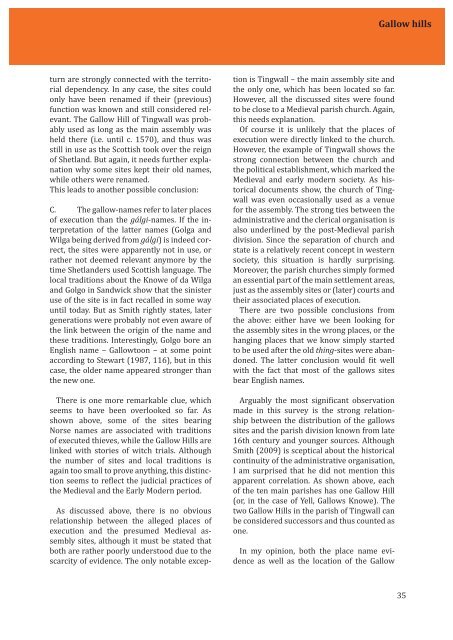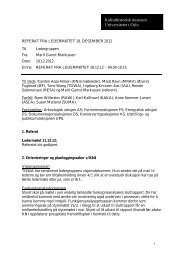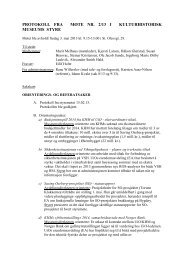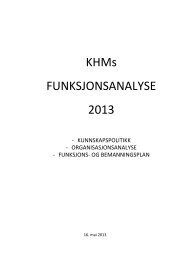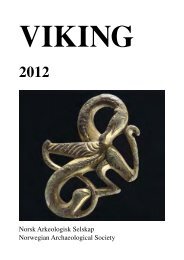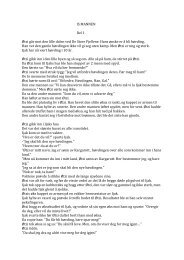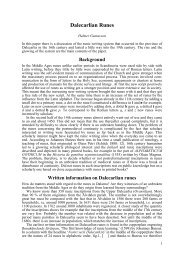TAP Field Report No. 5 A survey of Shetland's gallow hills Joris ...
TAP Field Report No. 5 A survey of Shetland's gallow hills Joris ...
TAP Field Report No. 5 A survey of Shetland's gallow hills Joris ...
- No tags were found...
Create successful ePaper yourself
Turn your PDF publications into a flip-book with our unique Google optimized e-Paper software.
Gallow <strong>hills</strong>turn are strongly connected with the territorialdependency. In any case, the sites couldonly have been renamed if their (previous)function was known and still considered relevant.The Gallow Hill <strong>of</strong> Tingwall was probablyused as long as the main assembly washeld there (i.e. until c. 1570), and thus wasstill in use as the Scottish took over the reign<strong>of</strong> Shetland. But again, it needs further explanationwhy some sites kept their old names,while others were renamed.This leads to another possible conclusion:C. The <strong>gallow</strong>-names refer to later places<strong>of</strong> execution than the gálgi-names. If the interpretation<strong>of</strong> the latter names (Golga andWilga being derived from gálgi) is indeed correct,the sites were apparently not in use, orrather not deemed relevant anymore by thetime Shetlanders used Scottish language. Thelocal traditions about the Knowe <strong>of</strong> da Wilgaand Golgo in Sandwick show that the sinisteruse <strong>of</strong> the site is in fact recalled in some wayuntil today. But as Smith rightly states, latergenerations were probably not even aware <strong>of</strong>the link between the origin <strong>of</strong> the name andthese traditions. Interestingly, Golgo bore anEnglish name – Gallowtoon – at some pointaccording to Stewart (1987, 116), but in thiscase, the older name appeared stronger thanthe new one.There is one more remarkable clue, whichseems to have been overlooked so far. Asshown above, some <strong>of</strong> the sites bearing<strong>No</strong>rse names are associated with traditions<strong>of</strong> executed thieves, while the Gallow Hills arelinked with stories <strong>of</strong> witch trials. Althoughthe number <strong>of</strong> sites and local traditions isagain too small to prove anything, this distinctionseems to relect the judicial practices <strong>of</strong>the Medieval and the Early Modern period.As discussed above, there is no obviousrelationship between the alleged places <strong>of</strong>execution and the presumed Medieval assemblysites, although it must be stated thatboth are rather poorly understood due to thescarcity <strong>of</strong> evidence. The only notable exceptionis Tingwall – the main assembly site andthe only one, which has been located so far.However, all the discussed sites were foundto be close to a Medieval parish church. Again,this needs explanation.Of course it is unlikely that the places <strong>of</strong>execution were directly linked to the church.However, the example <strong>of</strong> Tingwall shows thestrong connection between the church andthe political establishment, which marked theMedieval and early modern society. As historicaldocuments show, the church <strong>of</strong> Tingwallwas even occasionally used as a venuefor the assembly. The strong ties between theadministrative and the clerical organisation isalso underlined by the post-Medieval parishdivision. Since the separation <strong>of</strong> church andstate is a relatively recent concept in westernsociety, this situation is hardly surprising.Moreover, the parish churches simply formedan essential part <strong>of</strong> the main settlement areas,just as the assembly sites or (later) courts andtheir associated places <strong>of</strong> execution.There are two possible conclusions fromthe above: either have we been looking forthe assembly sites in the wrong places, or thehanging places that we know simply startedto be used after the old thing-sites were abandoned.The latter conclusion would it wellwith the fact that most <strong>of</strong> the <strong>gallow</strong>s sitesbear English names.Arguably the most signiicant observationmade in this <strong>survey</strong> is the strong relationshipbetween the distribution <strong>of</strong> the <strong>gallow</strong>ssites and the parish division known from late16th century and younger sources. AlthoughSmith (2009) is sceptical about the historicalcontinuity <strong>of</strong> the administrative organisation,I am surprised that he did not mention thisapparent correlation. As shown above, each<strong>of</strong> the ten main parishes has one Gallow Hill(or, in the case <strong>of</strong> Yell, Gallows Knowe). Thetwo Gallow Hills in the parish <strong>of</strong> Tingwall canbe considered successors and thus counted asone.In my opinion, both the place name evidenceas well as the location <strong>of</strong> the Gallow35


